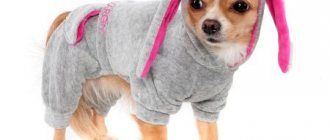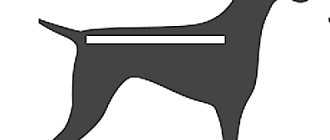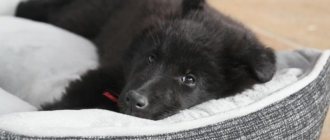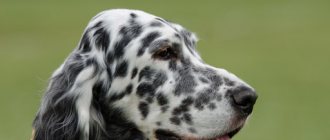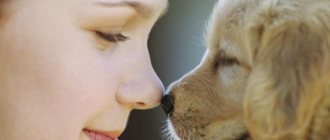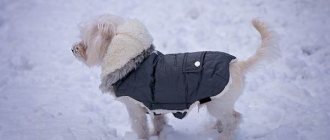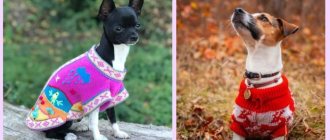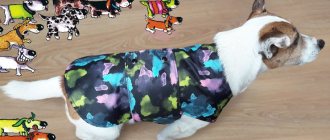The fact that the industry offers a wide range of clothing for animals no longer impresses or surprises anyone. Owners have at their disposal outfits both with a purely decorative function and those designed to protect dogs from moisture or cold weather. Without warm overalls, dogs may not survive our harsh winters, and no owner would want to let their pet get sick.
To ensure that the clothes fit properly, do not interfere with the dog, and are not too big or small, you need to be able to correctly take measurements to correctly determine the size. So many breeds with different proportions have been created by selection that average sizes simply cannot be used here.
Why do dogs need clothes?
First of all, to maintain health. In the modern world, a huge number of decorative exotic breeds have been bred that are simply not fit to live like dogs. For example, hairless Chinese dogs, completely devoid of hair, like humans, need to dress in winter so as not to freeze; and in the summer, so as not to burn in the sun.
And clothing for dogs of small breeds is simply necessary, since their rate of heat exchange is much higher than that of their larger relatives, so such animals freeze and catch a cold at the slightest draft or drop in temperature. Short-haired breeds are completely devoid of undercoat and clothing for them is additional protection from wind and frost.
Many dog breeds are cut in a grooming salon, removing a fairly large amount of insulated fur coat. As a result of the haircut, a sharp disturbance in heat exchange occurs and the dog can easily catch a cold in the first weeks after the haircut. An experienced groomer will definitely recommend putting clothes on your pet during this period.
In older animals, due to age-related changes in the body, natural thermoregulation malfunctions and they, like our grandparents, do not mind dressing a little warmer. In addition, older dogs very often suffer from arthritis and hypothermia can further aggravate this disease. Therefore, older dogs also need clothes.
A mother dog nursing babies can get colds in the mammary glands in winter and needs protection from hypothermia during walks in order to prevent mastitis.
In addition to keeping the dog healthy, clothing serves a protective function. Bolognese thin raincoats make life easier for the owner and significantly save his time during the period when there is slush outside. After all, washing the entire dog after each walk is much more difficult than simply washing the paws and wiping the overalls with a damp cloth. In addition, in winter, city sidewalks and roads are sprinkled with chemicals that negatively affect the skin of pets, often causing allergies. Dog boots also perform the same protective function, protecting paws from the aggressive effects of reagents.
Modern floor coverings such as linoleum, tiles, parquet, and laminate often cause injuries and dislocations in dogs living in apartments. The solution to this problem will be socks with anti-slip soles.
Briefs “for heat” will protect the female dog from unwanted mating, and the apartment and bedding from the discharge characteristic of this period.
Dog clothes are also a source of positive emotions. Many owners of decorative dogs just want to dress their pet glamorously and beautifully. How much joy and admiration it brings to each of us when our pets walking in dresses or in sports overalls and caps evoke in each of us.
Medium breeds
| Breed | Height | Weight (male) | Massa (bitch) |
| American Cocker Spaniel | 36–41 cm | 13–16 kg | 12–15 kg |
| English bulldog | 38–42 cm | 24–25 kg | 22–23 kg |
| Afghan Hound | 60–74 cm | 20–25 kg | 15–20 kg |
| Collie longhair | 51–61 cm | 20–30 kg | 18–25 kg |
| Siberian Husky | 51–60 cm | 20–27 kg | 16–22 kg |
| Welsh Corgi | 25–33 cm | 10–14 kg | 9–12 kg |
| Shar Pei | 45–50 cm | 23–25 kg | 20–22 kg |
How to choose the right costume for your pet?
The very first rule when buying clothes for a dog is to take your pet with you to the store to try it on. Be prepared right away that the fitting process will take some time, and you will have to try on at least five models to understand which one your “fashionist” or “fashionista” will feel most comfortable in. It is very important that the clothes fit loosely, do not restrict the dog’s movements, do not put pressure on the paws, neck, but at the same time do not “dangle”.
Clothing must match the pet's breed, taking into account its breed characteristics. There are separate sizes for dachshunds, corgis, bulldogs and pugs; you should not try to squeeze them into overalls for other breeds: they will be uncomfortable in the neck for bulldogs, and the length will not suit dachshunds. For hairless breeds, you should choose clothes with neat seams. Rough seams and textured fabric can cause discomfort for naked people.
The overalls should not be too big, otherwise there is a risk that when going for a walk, urine and feces will get inside the clothes.
Clothes for your pet should be easy to put on and take off. Preference should be given to zippers in the fastener, because Velcro fasteners very quickly become clogged with wool and no longer securely fix the suit.
The presence of a reflective strip on the overalls will allow you to control your pet’s movement in the dark and make it more visible to vehicle drivers. Knitted clothes are beautiful, but not so practical to care for and are not suitable for wearing when walking in wet weather.
When buying clothes, it is not enough to just try them on on a standing dog; you need to see how the pet moves in the new clothes - let him walk around the store for a few minutes.
You can ask the dog to sit, lie down, give a paw and, if possible, move up the stairs. While the dog is moving in new clothes, it is advisable to check with your hands whether the clothes are pulling in the armpits. If the dog behaves in clothes the same way as usual, it is comfortable, then the clothes were chosen well. A small exception to this advice would be dogs trying on clothes for the first time: out of habit, their movements will be noticeably constrained, but within 10–15 minutes the dog begins to behave more freely in a new image.
The simplest overalls pattern for your pet!
We sew clothes for a pet with our own hands
The time has long passed when clothing for animals was perceived as something unnecessary and preventing dogs and cats from living comfortably. Now no one doubts the need for such things, because modern clothing for pets is, first of all, comfort and the performance of certain functions - protecting the animal from frost, wind, moisture, dirt, dust, ticks and burrs and, of course, the sun rays.
Well, where there is demand, there are fashion trends!
1. Measure the length of the dog’s back (from the collar to the root of the tail) - points (Z-K); 2. Divide this length by 8 (example: 40 cm: 8 = 5 cm) - we get the side of one cell in cm (mm); 3. Draw a sheet of paper into cells with the corresponding side, according to the diagram; 4. O - (A-B); 9. Subtract the difference in these places between the real volumes of the dog and the flat image; 10. This difference is the width of the insert on the belly (between the two halves of the overalls)
11. Assembling the overalls into a single whole. We grind the insert in several steps:
a. We start with the neck. We extend it to the armpit (the end of the front leg) and, having secured it, break the thread. b. We begin to sew the “underbelly”, add it to the groin (the beginning of the back leg), fasten and break the thread. c. We begin to stitch the insert to the back leg to its middle (for bitches).
d. For male dogs, cut out the fly on the insert. The insert itself is longer than for bitches. Sewn from the neck to the tail hole (D-G-B-G). A dart is made on the belly side to ensure a tight fit of the overalls on the belly. The fly is finished with bias tape. (You can insert an elastic band, but it will be more rough. If you insert an elastic band, you do not need to make a dart). 12. Sew in a zipper. It can be detachable, or it can be one-piece. 13. Next, we trim the tail part of the overalls with bias tape, having previously made darts according to the figure, or you can do it without darts - with an elastic band inserted inside the tape. 14. We finish the neck part like the tail part. You can do a stand. We make a loop on one side, and sew a button on the other. You can sew on Velcro or insert a tie cord. 15. We hem the trouser legs according to the dog’s height. We insert the elastic bands down. Attention! There should be a slight slouch at the bottom of the shalwar style pants to allow the dog to move comfortably! 16. The overalls are ready.
Selecting the size of clothes for a dog
To choose the right clothing size for your pet, you need to know two main parameters: back length and chest circumference. Neck volume is also equally important, but not all manufacturers indicate this parameter in their size tables. The comfort of the collar can only be understood during the fitting process.
If you have already had experience buying clothes, you don’t need to focus on the size that your pet wears now, you need to know exactly the sizes. The fact is that each manufacturer has its own line of clothing sizes; if a pet wears size S from one company, this does not mean that size S from another will suit him.
Also keep in mind that different models from the same company, of the same size, will fit the dog differently: soft velor and fleece models are always more comfortable and have better stretch, unlike insulated items made from raincoat fabric or fur. Clothing models can also be different - depending on the style, things can be either tight-fitting or quite loose.
When taking your dog’s measurements and choosing clothes based on them, remember that each manufacturer indicates sizes differently: some give volumes taking into account a loose fit, others indicate volumes with a tight fit. This is another argument that you should not buy clothes without trying them on.
Sewing tips
So, you finally decided to sew clothes for your pet yourself, rather than buying expensive and faceless dog clothes in the store. It’s wonderful, because hand-sewn clothes will make your four-legged friend individual, and your little pet will definitely appreciate such care for him. How to sew clothes for a dog using patterns?
The quality of the pattern made and the subsequent production of clothes for small dogs will depend on how correctly you took your pet’s measurements.
Small dogs should be measured as follows:
- first of all, we measure the length of the pet (along the back) from the withers to the tail;
- then we measure the height of the paws from the floor to the dog’s sternum;
- then you need to measure the dog’s belly;
- Next, measure the length from the dog’s neck to its groin (this size will depend on the gender of the pet);
- The last thing to measure is the animal’s body and its circumference.
The measurements have been taken, the next stage will be making patterns and sewing clothes. The process of creating patterns and modeling clothes is very important. This will require considerable perseverance and attention. You can look for diagrams and patterns in this article. Below you will find what you need. The article contains not only photos, master classes, but also a video on how to sew clothes for small dogs.
1) Pattern of overalls with a hood for a Chihuahua:
2) Clothes for Yorkies:
3) Pattern of shoes for toy terriers:
If transferring the made pattern directly onto the fabric should not cause any particular difficulties, then the choice of material from which you will create clothes for your pet should be taken very seriously.
The choice of fabric for sewing clothes for a pet depends on seasonality. It must be remembered that summer is diametrically opposed to winter. For winter clothes, it is better to choose warmer materials; it would be useful to use insulation (sintepon).
Spring and autumn clothing should be waterproof and repel dirt well.
Remember, tailoring clothes for dogs is impossible without high-quality accessories: buttons, zippers, Velcro, hooks and fasteners. The fittings must be strong and beautiful.
Taking measurements from a dog
Taking measurements to select the size is done with a special soft tailor's measuring tape. What is important is a soft tape, and in no case a tape measure, which can easily injure your pet. A simple ruler will also not be able to accurately take measurements correctly.
The dog should be placed on a flat, hard surface (not on a bed or on a sofa), stand straight, without bending or squeezing. To more accurately determine the length of the back, a collar is put on the dog, and it is from this that the reporting point begins. The second point will be the base of the tail, i.e. the last sacral vertebrae, not the first caudal vertebrae. The resulting value will be the long back.
Now you need to measure your chest circumference. This measurement is taken at the widest point of the ribs: a measuring tape must be passed around the chest just behind the dog's elbows. If the dog is very shaggy, the measuring tape should not fit tightly to the body.
The girth of the neck is equal to the size of the collar the dog wears. The neck circumference is measured at its widest point. The neck should be measured not end to end, but looser. When choosing a clothing model, be sure to look at the neck style, which can be high or loose. In no case should the neck be too tight so as not to squeeze your pet’s neck.
After taking all the measurements, the obtained parameters must be compared with the manufacturer’s size chart and the desired size of clothing for the animal must be selected. For borderline sizes, it is better to start by trying on larger sizes. If the dog is of a dense build and has a voluminous chest, you need to add another size so that the product fits well and the dog is comfortable. If your pet is slim or lean, then a smaller size is needed.
Large breeds
| Breed | Height | Weight (male) | Massa (bitch) |
| Alabai | 70–80 cm | 72–80 kg | 65–72 kg |
| English Mastiff | 69–79 cm | 71–73 kg | 67–69 kg |
| Dalmatian | 56–59 cm | 26–28 kg | 23–25 kg |
| Doberman | 63–72 cm | 40–45 kg | 32–35 kg |
| Golden retriever | 51–61 cm | 27–36 kg | 25–32 kg |
| German dog | 72–90 cm | 63–79 kg | 50–63 kg |
| German Shepherd | 55–65 cm | 30–40 kg | 25–32 kg |
When buying a purebred puppy, it will be useful to find out the dimensions of its parents or find out about the height and weight of puppies from previous litters of this pair of dogs. This is a more reliable guideline than the average values for all representatives of the breed.
Choosing shoes
To determine your shoe size, you also need to take measurements. The dog's paw is placed on a white sheet of paper and the distance from the claws to the heel is noted. The resulting marks are measured with a ruler and the size suitable for the dog is checked using the manufacturer’s table.
Even an outfit chosen correctly according to the measurements taken must be tried on. After all, in addition to the main measurements, there is also the volume of the abdomen, and what is suitable for a lean dog will be very tight for a robust one. It is also important to take into account the anatomical features of the structure, for example, in males, pay attention to whether, when walking the dog, urine will not get inside the overalls. The dog's clothing should be comfortable and comfortable. The dog will not say that it is rubbing or uncomfortable. Temperamental “hot” dogs may even tolerate and ignore the pain until an incorrectly chosen suit rubs their skin sore. Therefore, only a loving and attentive owner, together with an experienced seller, will be able to correctly select exactly what will not cause the dog any disturbance.
Small breeds
| Breed | Height | Weight (male) | Massa (bitch) |
| Jack Russell Terrier | 25–30 cm | 6–7 kg | 5–6 kg |
| Yorkshire Terrier | 15–17 cm | 2–3 kg | 2–3 kg |
| Papillon | 20–28 cm | 3–5 kg | 3–5 kg |
| Pekingese | 15–25 cm | Up to 5 kg | Up to 5.5 kg |
| Pomeranian Spitz | 18–22 cm | 2.2–3.2 kg | 1.4–2.5 kg |
| French Bulldog | 25–35 cm | 10–15 kg | 8–12 kg |
| Chihuahua | 17–23 cm | 2.3–3 kg | 1.8–2.5 kg |
Varieties of things
There are a lot of options for clothing for Chihuahua dogs - for all occasions.
Decorative
Some dog clothes are designed to protect from the bright sun or frost, while others have a purely decorative function and are created for beauty. For this purpose, clothes for Chihuahua girls are often purchased, which create a cute image and are pleasing to the eye. It will be difficult not to notice such a dog. Popular colors for decorative accessories: pink, milky and yellow for girls and all shades of blue for boys.
Light summer
An ideal option for summer is a microfiber cape or cotton dress for your Chihuahua. These types of fabrics are highly breathable. A summer outfit not only decorates your pet, but also provides protection from heat stroke. It is recommended to purchase a cap or hat to avoid overheating of the head.
Attention! Overheating is no less harmful for a dog than hypothermia.
Demi-season
Sweaters and jackets for Chihuahuas will be popular for spring and autumn. For dry, cool weather, lined suits are suitable: a jacket and pants. Demi-season items are always made from insulated materials, for example, flannel or wool, as well as moisture-resistant raincoat fabric with a flannelette insert.
Clothing must be suitable for weather conditions
Winter
In cold weather, Chihuahuas are dressed in closed overalls that fit tightly to the body. They may have an insulated hood or collar that covers the neck from the wind. Bright models with reflective stripes are valued, allowing you to find your pet even against the backdrop of snow. In winter, hats are welcome, if there is no hood. You can buy a hat or make it yourself, for example, from yarn. Knitting patterns are taken from the Internet and thematic magazines.
Shoes
In addition to clothing, pet stores offer shoes for animals. It is designed to protect the paws of a sensitive dog from puddles, snow, as well as harmful substances and traumatic objects. Light models, more like slippers or socks with thick soles, are chosen as the first shoes. Once your Chihuahua gets used to them, you can purchase more serious shoe options, such as sneakers or winter boots.
Necessary materials
You can use soap instead of chalk
In order to sew any thing, you need patterns. There are a large number of ready-made patterns for overalls for dogs, changing which in accordance with the measurements taken, you can make a magnificent product.
To sew a jumpsuit you will need:
- two types of fabric - outer fabric, preferably waterproof, and lining. When choosing fabric, consider how comfortable your pet will be in the clothes. This is especially true for the lining. Flannel, cotton, fleece and other soft and warm fabrics are chosen for it;
- threads;
- tractor zipper;
- two elastic bands;
- Velcro;
- tape measure;
- graph paper; if you don’t have it, you can use old wallpaper;
- sewing machine;
- chalk;
- scissors;
- pins.
